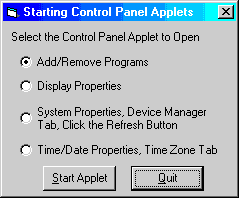Start Control Panel Applets Using Rundll32.Exe
The Windows Rundll32 command line utility allows
you to run a 32-bit function exported from a DLL. However, you cannot
call any exported function from any DLL. For example, you cannot call Win32
APIs exported from system DLLs such as Kernel32.dll. Rundll32
only allows you to call functions from a DLL that are explicitly written to be
called by Rundll32.
So what can you call? The Rundll32.exe utility
allows you perform tasks such as starting Control Panel applets, launching Dial
Up Networking (DUN), formatting a floppy disk from your Visual Basic program,
de-branding Internet Explorer,...
This page shows how to use Rundll32. However, you
can also open Control Panel, Dial Up Networking, My Computer, the Printers and
Network Neighborhood folders and more by shelling out to Explorer. The attached
Explorer.txt file shows how to do that as well.

Download Source Code
Rundll32.exe <dllname>,<entrypoint> <optional arguments>
Always specify the full path to the dll and use the short name convention.
You can use my Convert Long Path Names to Short (8
Character) Names program to convert a long path the the 8-character
short path equivalent.
Exact syntax is critical as is the case of the dll and function being
called. There should be no white space between <dllname> and the
comma or the comma and <entrypoint>. If Rundll32
fails, it will most likely do so without providing any error information.
| Launching Control Panel Applets
|
Call Rundll32 as:
Rundll32.exe shell32.dll,Control_RunDLL <cpl app>,<applet>,<page>
Where:
Control_RunDLL
|
Case Sensitive.
|
<cpl app>
|
Name of Control Panel applet to open.
|
<applet>
|
If the applet contains multiple applets, such as the
printer applet, this indicates which one to open. Numbering is zero-based
preceded with "@".
|
<page>
|
The one-based page or Tab within the applet to display.
|
Names of some common Control Panel applets:
Name
|
Description
|
AppWiz.cpl
|
Add/Remove Programs
|
Desk.cpl
|
Display Properties
|
Inetcpl.cpl
|
Internet Properties
|
Intl.cpl
|
Regional Settings Properties
|
Joy.cpl
|
Joystick
|
Main.cpl
|
Mouse Properties
|
Mmsys.cpl
|
Multimedia Properties
|
Modem.cpl
|
Modem Properties
|
Odbccp32.cpl
|
32 bit ODBC Data Source Administrator
|
Password.cpl
|
Password Properties
|
Sysdm.cpl
|
System Properties
|
Themes.cpl
|
Desktop Themes
|
Timedate.cpl
|
Date/Time Properties
|
Wgpocpl.cpl
|
MS Workgroup Post Office
|
Netcpl.cpl
|
Network Properties
|
| Launching Dial Up Networking
|
Call Rundll32 as:
Shell("Rundll32.exe rnaui.dll,RnaDial " & sDialUpName, vbNormalFocus)
Where:
sDialUpName - Name of you Dial Up
Networking connection as it appears in the
Dial Up Networking Control Panel
applet.
Note: You can also dial your default internet connection using my
Open/Print Files, View Web Sites, Connect to the Internet program.
Call Rundll32 as:
Shell ("Rundll32.exe shell32.dll,SHFormatDrive")
| De-Branding Internet Explorer
|
Call Rundll32 as:
Shell ("Rundll32.exe iedkcs32.dll,Clear")
You can also click the Start Menu, click Run and type in "rundll32
iedkcs32.dll,Clear" without the quotes then hit Enter.
Download the source program. Press F5 to run it. Click the desired option
then click the Start Applet button.
|